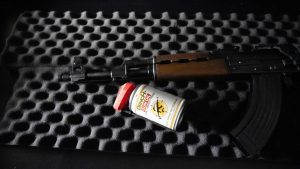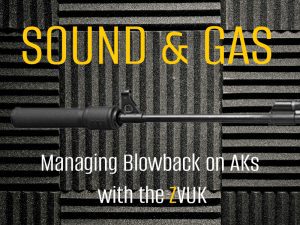So your can will not budge.
You twist.
You grunt.
You consider googling ancient Serbian curse words.
Relax. You can fix carbon-locked suppressor threads without drama, and you can do it while keeping your Zastava rifle and muzzle threads in top shape.
We’ll walk you through simple steps first, then stronger tactics, and I’ll close with habits that stop lockups before they start.
Safety First, Always
Before you fix carbon-locked suppressor headaches, set the stage:
- Unload the rifle! Chamber clear, mag out, no exceptions!
- Lock the bolt to the rear or remove the dust cover and carrier on an AK if that helps you verify clear.
- Wear gloves with a real grip. Hot parts and sharp edges do not negotiate.
- Stabilize the firearm. A padded vise with a proper upper/barrel block or a bench cradle keeps torque off delicate parts.
You want control, not extra force on the gas block, sight tower, or barrel shoulder.
Understand Why Carbon Lock Happens
AK gas dumps soot everywhere. Hot soot plus oil and copper forms a gritty paste. Heat cycles set that paste like concrete. Direct-thread cans take it on the chin because fouling loves threads.
Mix in a bit of over-torque and you now own a stuck-on tube. The good news: the threads on Zastava barrels and mounts hold strong when you follow a sane removal plan.
Try These Methods First
You want clean, progressive force and heat where metal interfaces meet.
- Warm The Joint, Not The Whole Rifle: Heat helps the metal expand a hair and softens the crust. Aim low and local with a heat gun or hair dryer. Move the nozzle. Keep the heat on the suppressor base and the first thread section, not on wood furniture or polymer. A minute or two often does the trick.
- Use Two Wrenches, Add Opposing Grip: One strap wrench on the suppressor tube, another on the mount, or a wrench flat near the base. Hold one, turn the other. Left-hand M14×1 threads on many Zastava AKs turn clockwise to loosen. Say it out loud before you start so muscle memory does not tighten the can by mistake.
- Break The Seal, Then Pause: As soon as the joint moves, stop. Add a few drops of light oil to the threads while warm. Let capillary action do its thing for 60 seconds. Then continue. Small “nudge-pause-nudge” cycles beat one long heave.
- Use the “Warm-Then-Glove” Technique: With the joint warm, switch to a grippy glove and twist by hand. Hands feel alignment better than tools and reduce the chance of cross-thread drama as the can starts to back out.
Tactics For Stubborn Joints
If the easy playbook fails, step up with patience, not brute force.
- Thermal Cycling: Warm the base. Twist. If it still refuses, let the assembly cool to room temperature or place the muzzle end in front of a cold air stream for a short spell. Then add heat again. Two or three cycles move many “welded” joints. Avoid dunking the hot suppressor in water; shock can crack deposits, but also stress metal.
- Solvent Assist (Thread-Safe Only): Use a carbon remover that lists steel compatibility and no chloride content. Apply a small amount at the joint line. Stand the rifle muzzle down on a pad so gravity works for you. Give the chemistry five to ten minutes, then repeat the warm-and-twist sequence. Keep liquids out of the bore and gas port.
- Reaction Fixture or Vise Blocks: If you own proper blocks for your platform, secure the barrel so torque does not load the gas block or sight. Keep force along the bore line. Short, controlled pulls beat a big cheater bar.
- Last-Resort Micro-Taps
Light taps around the suppressor base with a nylon or brass tool can fracture the carbon crust. Tap, warm, twist. Think “metronome,” not “hammer time.”
What NOT To Do
- Skip pliers with toothy jaws. They crush tubes and chew the finish.
- Skip pipe wrenches on the body. Save those for plumbing.
- Skip crush washers between a suppressor and the muzzle. Use a proper shim set when you need an index.
- Skip open flames. You want heat, not scorch.
Inspect The Threads After
You freed it. Nice. Now you fix carbon-locked suppressor problems for good by cleaning the mating parts.
- Clean the Barrel Shoulder and the First Few Threads: A bronze brush, cotton swabs, and a lint-free patch handle most crud. If you see stubborn scale, use a mild carbon remover and a nylon brush.
- Check For Burrs: Run a wooden toothpick along the thread flanks. If it snags, you may have a burr. A proper thread chaser or a competent armorer can refresh threads fast.
- Check Concentricity: Zastava alignment rods help you confirm a straight bore-to-bore layout. Slide the rod and verify it centers “dead even” through the suppressor exit. Perfect alignment reduces future fouling and protects the baffle stack.
Lockout Prevention
You came here to fix carbon-locked suppressor issues. Now let’s stop repeats.
- Use Zastava HOT-LOCK On Clean Threads: HOT-LOCK high-temp anti-seize forms a thin barrier that resists carbon crust and galling on steel and titanium threads. A rice-grain stripe on the first two threads does the job. Wipe the excess.
- Seat, Then Set: Spin the can on by hand until it seats on the shoulder. Apply a firm hand snugly. Add a modest bump with a torque tool or strap wrench if your mount calls for it, then stop. Over-torque equals future pain.
- Break The Joint While Warm: After each range session, crack the can free while it sits warm (gloves on). Spin it a quarter turn out, then back to snug for storage. That micro-motion clears soot before it cures.
- Clean On A Schedule: After high-round weekends, brush the threads. Wipe the blast baffle area and the mount face. Small habits beat heroic rescue missions later.
- Mind Ammo And Gas: Over-gassed rifles throw extra soot. Zastava rifles run robust systems, but if you see heavy face deposits, consider a tune-up: inspect the muzzle device, verify thread fit, and confirm proper alignment. Cleaner flow equals less carbon lock.
Simple Toolkit That Pays For Itself
- Two-strap wrenches
- Heat gun or strong hair dryer
- Nylon/brass scraper and a bronze brush
- Lint-free patches and a thread-safe carbon remover
- Zastava alignment rod
- Zastava HOT-LOCK for reassembly
With that kit, you can fix carbon-locked suppressor joints at home and keep your Zastava setup ready for the next range day.
Final Words
You now own a clear plan to fix carbon-locked suppressor problems on your Zastava rifle. Start gently, add heat with control, use proper grip, and escalate with patience.
Finish with clean threads plus HOT-LOCK, and you cut future lockups to near zero. Range days stay fun, tools stay in the drawer, and your Zastava keeps that smooth, balanced feel you bought it for.



